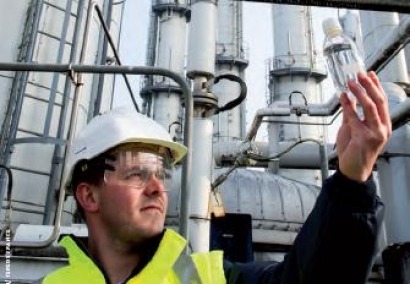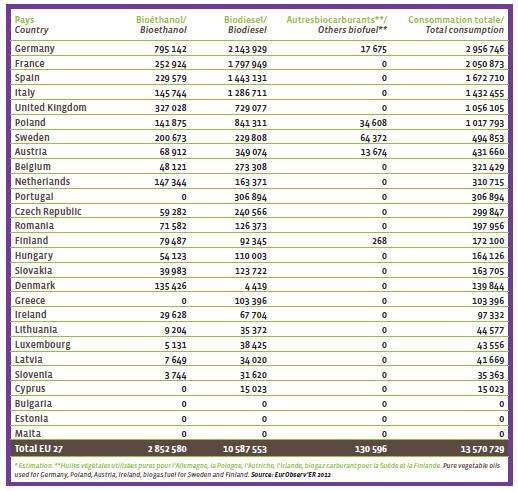
EurObserv’ER’s latest Biofuels Barometer shows that overall biofuel consumption continued to increase by 3% in Europe between 2010 and 2011, which translates into 13.6 million tonnes of oil equivalent (toe) used in 2011 compared to 13.2 million toe in 2010.
Biofuel consumption for transport in Europe Union, 2011 (toe)

However, according to the authors of the report, European Union governments no longer view the rapid increase in biofuel consumption as a priority, and this has contributed to a decline in the growth of biofuel consumption in transport from, 41.7% between 2007 and 2008, 24.6% between 2008 and 2009 and 10.7% between 2009 and 2010, to only 3.0 % between 2010 and 2011.
“The European Union’s attention has shifted to setting up sustainability systems to verify that the biofuel used in the various countries complies with the Renewable Energy Directive’s sustainability criteria,” finds the report.
The reason for this downslide is the 2020 target that requires less effort than that of the 2003 Biofuel Directive (which aimed at a 5.75% share in 2010) and has also pushed back the date by which Member States must incorporate biofuel into their national markets.
Today’s priority is to ensure that the biofuel consumed within their national boundaries meets the sustainability criteria set in the Directive. Thus Germany, France and other EU countries have set a threshold before they decide on any future increase in their incorporation rate. Some importer countries (primarily Central European) have lowered their incorporation rate or kept it low to ease their economies as they ride out the recession. Between 2010 and 2011, just a handful of countries decided to increase their biofuel incorporation rates in the fuel total – namely, Finland (4 to 6%), Poland (5.75 to 6.2%), Italy (3.5 to 4%), Spain (5.83 to 6.2%), Bulgaria (3.5% to 5% in volume), the Netherlands (4 to 4.25%) and Denmark (first quota set at 3.5%).
Biodiesel is still the main biofuel in European transport with a 78% share of total consumption, as against 21% for bioethanol. Biogas fuel consumption (0.5%) is still a purely Swedish phenomenon and vegetable oil consumption has reverted to marginal status (0.5%) since Germany started taxing this product
Sales of E10, a fuel made up of 90% unleaded petrol and 10% bioethanol by volume in some countries are behind the faster growth in bioethanol consumption (6.2% up on 2010) compared to biodiesel (2.4%). The European Commission would like E10 to be the main petrol fuel used in all the Member States by 2013.
In 2011 the situation is just as tense as it was for European biodiesel last year. The European Biodiesel Board’s (EBB) first estimates are that European Union production receded for the first time, dropping 8% from 9 570 000 tonnes in 2010 to 8 800 000 tonnes in 2011. The EBB says it will publish firmer figures in October.
This means that European industry did not gain from the slight increase in biodiesel consumption. For the first time European plant capacity utilisation, put at 22 117 000 tonnes in 2011, should drop below the 40% mark, which has put a number of European operators in dire straits. The Spaniards in particular have been forced to close their plants and lay off workers.
Where does this leave the 2020 targets?
As it stands, biofuel consumption in transports (13.6 Mtoe in 2011) is lower than anticipated in the National Renewable Energy Action Plans (14 Mtoe in 2010), amounting to a level a little over one year behind schedule. The data published in these NREAP plans was compiled then updated by ECN in November 2011 in its report “Renewable Energy Projections as Published in the National Renewable Energy Action Plans of the European Member States”.
This publication forecast 14 038 ktoe of biofuel consumption in transports in 2010 (2 871 ktoe of bioethanol, 10 956 ktoe of biodiesel, 211 ktoe of other biofuels), 19 778 ktoe in 2015 (4 968 ktoe of bioethanol, 14 542 ktoe of biodiesel, 268 ktoe of other biofuels) and 29 745 ktoe in 2020 (7 307 ktoe of bioethanol, 21 649 ktoe of biodiesel, 789 ktoe of other biofuels) (graph 3).
“Given the Directive deadline, which was still nine years away in 2011, this delay gives no cause for concern. The 2020 target,” find the authors of the Biofuels Barometer. “As a matter of course and based on the more intense use of second-generation biofuels, consumption growth should be more buoyant in the second half of the decade. This conservative view partly reflects the forthcoming developments of sustainability criteria, primarily involving factoring in the Iluc effect. A number of countries such as Germany have also deliberately cut back the development of 1st-generation biofuels to leave considerable room for 2nd-generation biofuels to expand. However, in the light of the efforts required to develop them industrially, this growth cannot start until the second half of the decade.”
The authors go on to say that prospects for first-generation development in Europe are limited by the dearth of dedicated farming land and the trends in global demand. For instance, Brazil, which only a short while ago was the leading bioethanol exporter has now become its leading importer. The drop in domestic production, as a result of a bad harvest, has even prompted the Brazilian government to reduce the incorporation rate in petrol from 25 to 20%. American bioethanol exports, which are currently frustrating European industry sales, could also end up lessening. Continued high prices paid for petrol in the US have increased pressure to increase the bioethanol incorporation rate there, which is already almost up to 10%. In January 2011, EPA, which is responsible for regulating biofuel incorporation, authorised petrol blends with 15% ethanol for vehicles made after 2001, which means that about two-thirds of the vehicles on the road in the United States can use E15. The 2007 Energy Independence and Security Act provides for increased consumption of 9–36 billion US gallons of ethanol by 2022 (34–136 billion litres), which means that American consumption will steadily grow. Accordingly, the development of second-generation biofuels could start much sooner than expected – as early as the middle of the decade. The use of ligno-cellulosic biomass and algae will lead to clearer environmental benefits and relieve the pressure on farming land.
For additional information:

